The 12th edition of the Rencontres de Bamako, otherwise known as the African Biennial of Photography reached two important milestones this year by celebrating its 25th year anniversary since its inception in 1994, and more significantly, it was the first edition produced solely by the Ministry of Culture of Mali
As N’diaye Rama Diallo, Minister of Culture of Mali commented, “This visceral need to reclaim one’s history and to promote another image of oneself comes from the persistence, in some Western minds, of a vast cliché concerning Africa, where savannas intermingle with abundant fauna; tribal, ethnic or clan warfare; exotic folklore; epidemics, and chronic famines; in short, a panoply of preconceptions that does not do justice to the history of Africa, to the diversity of its (cultural) riches, or to the genius and fertile enthusiasm of Africans.
Under the Executive Directorship of Lassana Igo Diarra, the democratization of the event was of utmost importance, and under the artistic direction of Bonaventure Soh Bejeng Ndikung, together with his co-curators Aziza Harmel, Astrid Sokona Lepoultier and Kwasi Ohene-Ayeh, they implemented various approaches that saw around 95% of all the work on exhibition being produced in Bamako itself. This is significant given the commitment by the new event leadership to localise production to benefit the local community and economy of Bamako.
There was also an ambitious scale to this year’s edition which saw the National Museum of Mali decentralized as the key exhibition site with the exhibitions and talks spread across the city and presented in numerous iconic venues including Musée National, Palais de la Culture, Memorial Modibo Keita, Musée du District, Conservatoire des arts et métiers multimédias, Institut Français, Galerie La Medina, Famille Fall, Theatre Blonba with a DJ set at the infamous Bla Bla bar.
THE SUDDEN SCAMPERING IN THE UNDERGROWTH: On presence of the invisible, the remote and other ghostly matters
ERIC GYAMFI
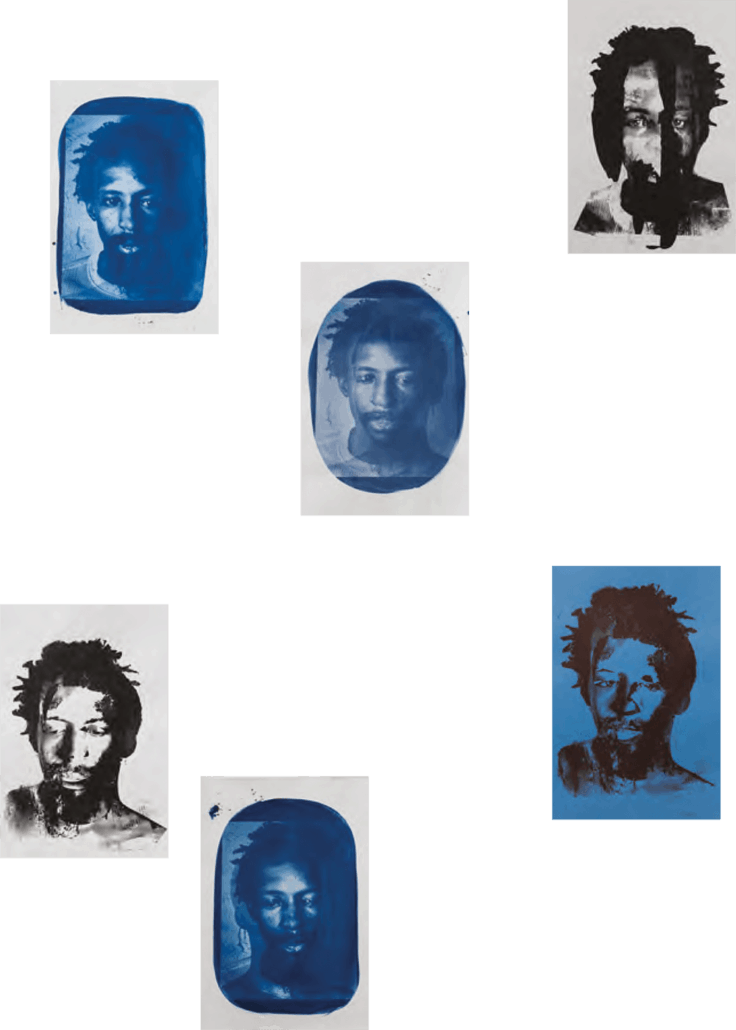 Fixing Shadows, Julius and I, 2018-2019, photo and sound installation. Courtesy of the artist.
Fixing Shadows, Julius and I, 2018-2019, photo and sound installation. Courtesy of the artist.
Fixing Shadows, Julius and I begins with an interest in what happens to the life of a photograph as it moves through time. The work looks at the space between two photographs—the first is of black American composer, vocalist, pianist, and dancer Julius Eastman and the other is the artist’s Gyamfi’s own self-portrait. Read as coordinates, the project attempts to map out, through different times, and encounters, the possibilities and potentialities that a space could embody. The installation consists of some 2000 silkscreens and cyanotype prints (measuring between A2 and A5) made over the course of a year and mounted directly on a 300 x 500 x 30 structure. A one hour, twelve-minute audio track, stitched together from Whatsapp voice notes collected from friends of the artists, loops. The audio recordings are prompted by Gyamfi’s desire to extend portraiture beyond the flatness of a picture. They are compilations of voice notes directed to him from friends who are describing the two portraits he had sent to them and how they individually read them. The rectangular structure displays a palimpsest of images composed in grid form, and (re)produced from the two original portraits. Gyamfi’s work equally considers what is on the surface of a photographic support with the narrative and formal components of an idea. If photography is considered to privilege the eye as its default logistic of perception, Gyamfi extends the physicality of the image and its consequent frontality into aural, textual, and structural dimensions. His work invites us to also consider photography in its extra-pictorial forms.
FANYANA HLABANGANE
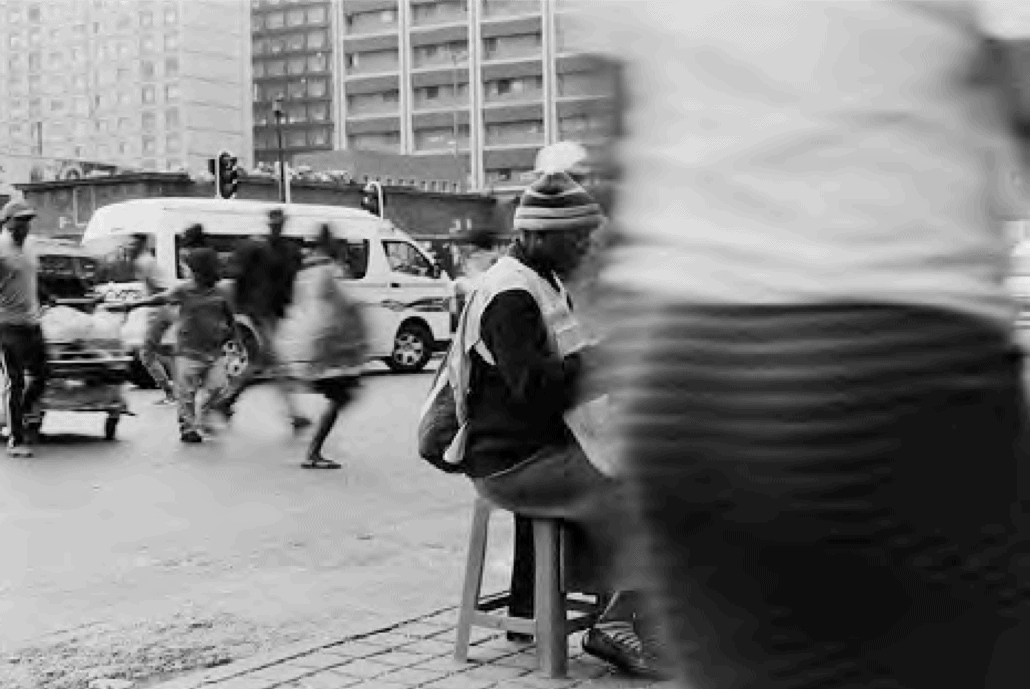 Silent Conversations (Graceful Chaos), 2017-2019, photograph.
Silent Conversations (Graceful Chaos), 2017-2019, photograph.
Fanyana Hlabangane’s black-and-white photo series captures human figures, architectural forms and other objects in mundane, private, or solitary moments within the city of Johannesburg. Trained as a scriptwriter, the artist intimately identifies with solitude and extends this through his camera by searching the streets and documenting lone figures who serve as reminders or mirrors of his own condition. He is fascinated with the possibility of using the camera to register our interior spaces as well as people or the inner thoughts that may well remain hidden and buried in the recesses of our minds. Through his camera, he establishes an identification with subjects of interest who are generally unaware of his presence. These are people who are either in conversation or who seem to be at odds with their environments. For Hlabangane, there is a scale to the city of Johannesburg which not only dwarfs one’s sense of belonging, but can also undermine one’s hopes and dreams. Yet every waking moment in a city like this can only be realized in its granular essence and experienced in the realm of the interior—that unnerving place of solitude.
BUHLEBEZWE SIWANI
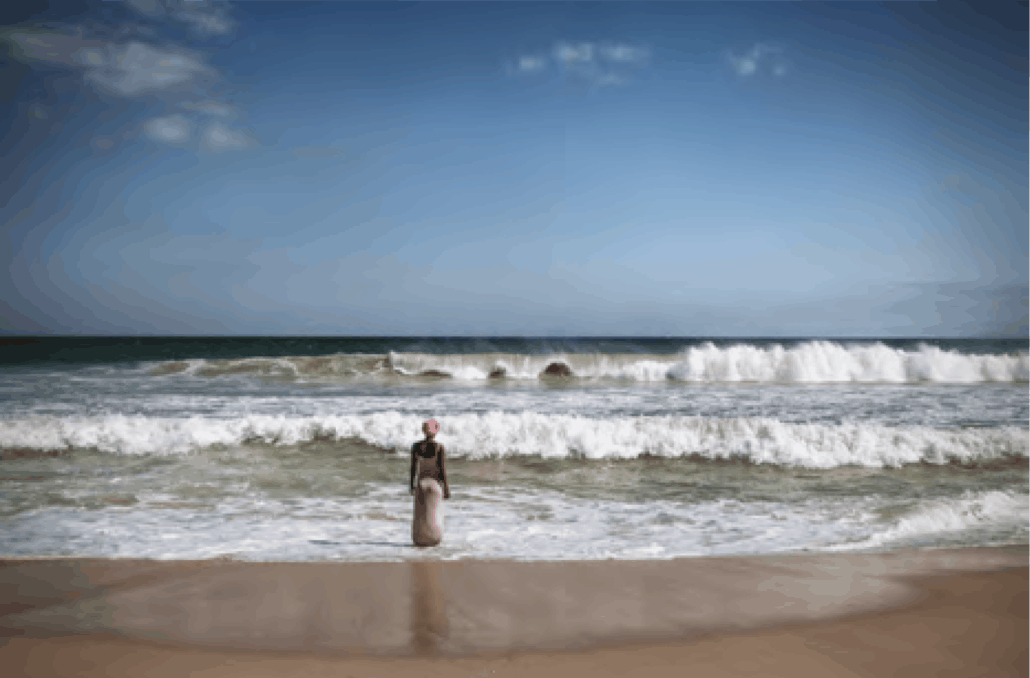 AmaHubo, 2018, 3-channel video, 13ʹ01ʺ. Courtesy of the artist and WHATIFTHEWORLD/.
AmaHubo, 2018, 3-channel video, 13ʹ01ʺ. Courtesy of the artist and WHATIFTHEWORLD/.
Buhlebezwe Siwani’s work generally interrogates the patriarchal framing of the black female body as well as the black female experience within the South African context. Her work also examines the impact of western ideals of beauty, power, gender, and spirituality in today’s South African society. AmaHubo is a three-channel video installation which derives its subject matter from the denigration and demise of African religious and spiritual beliefs owed largely to the Euro-Christian conquest and colonization of South Africa. Of particular interest is the instrumentalization of the black female body and how it attests to the stories carved into the bodies and minds of black women—whether they are believers in Christianity or traditional healers. The video also infuses this cultural politics (of racism, gender- and religion-based subjugation) with an awareness of the economic structures ensuring dispossession and exploitation at the same time in post-apartheid South Africa. AmaHubo situates itself at the junction where these worlds intersect.
IBRAHIM AHMED
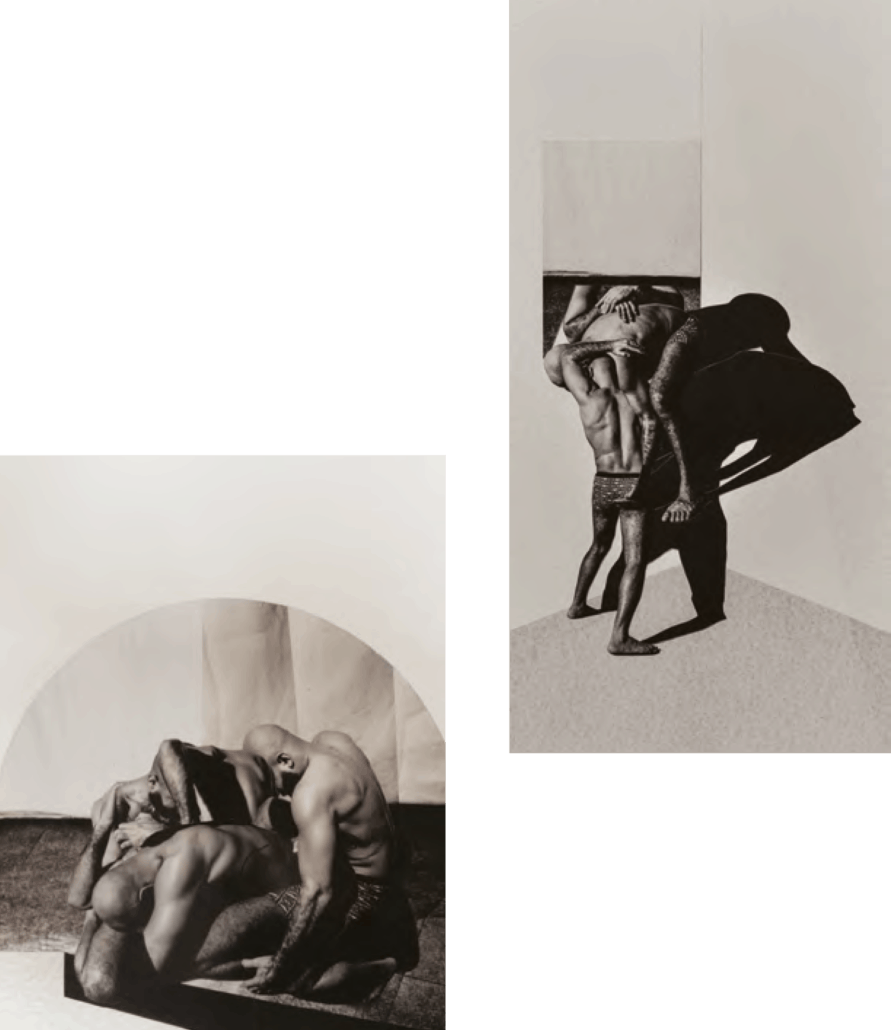
Burn What Needs To Be Burned is a body of work in which Ibrahim Ahmed comes to terms with the tensions between traditional masculinity and the creation of the individual self. The black-and-white and colour sequences are collaged and montaged compositions through which the artist articulates a contestation of these ideologies vis-à-vis “mutilated” or exaggerated self-portraits with digital manipulation techniques of hollowing out, flatten- ing, and layering of both narrative and photographic form.
BADR EL HAMMAMI
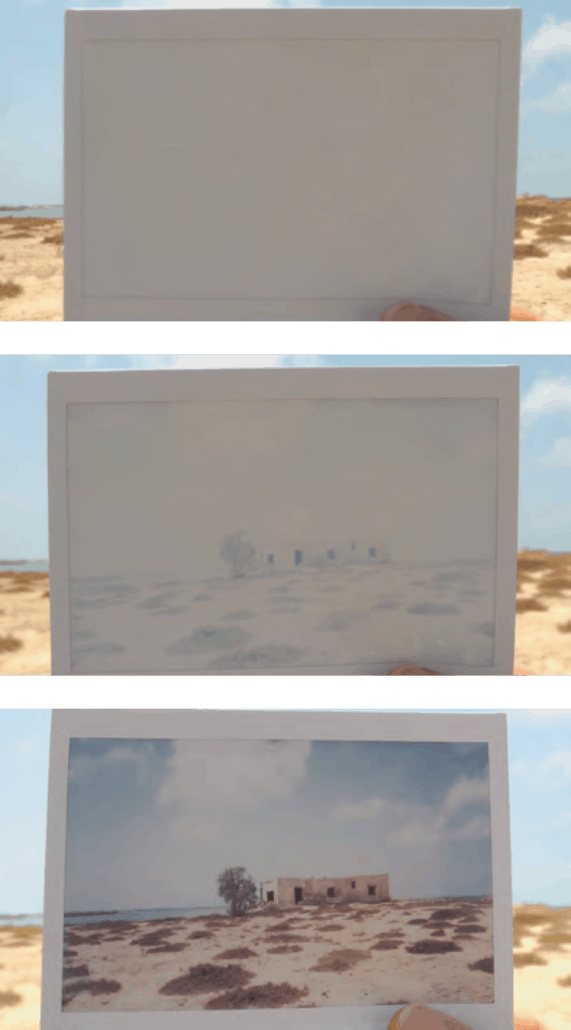 Mirage, 2018, video HD 16/9, 9ʹ. Courtesy of the artist.
Mirage, 2018, video HD 16/9, 9ʹ. Courtesy of the artist.
Badr El Hammami’s artistic process confronts otherness through negotiation, collaboration, and exchanges with street vendors, primary school children, or other artists. In his works, notions of displacement, migration, borders and politics go through personal filters related to memory and family. In his postcard series Greeting from Kerkennah, the artist combines the use of tourist postcards from the Kerkennah Islands in Tunisia, maps retrieved from inhabitants of the Island, and other images mined from the Internet—adjoining the physical with the virtual. At first glance, the images, which are frontally displayed, may depict an unsettling or utopian landscape. But a closer inspection reveals nuances of soft, smoky sears that inconsistently mediate the touristy aura of each of the postcards. This technique potentially subverts the narrative consistency in the postcards and also acts to transform the image as such. This effect is created by the artist who intentionally paints and scorches the postcards.
The moving image work Mirages: Kerkennah depicts a series of short videos produced in situ. These filmed performances overlay Polaroid snapshots onto real landscapes. But the Polaroids (or still images) almost totally conceal the real landscape in the moving image, while the image of the real landscape is hinted at slightly through the photosensitive paper. The work questions our relationship to the screen, which is very present in our daily life, and also to the information we tend to consume on a daily basis without contention.
ABRIE FOURIE
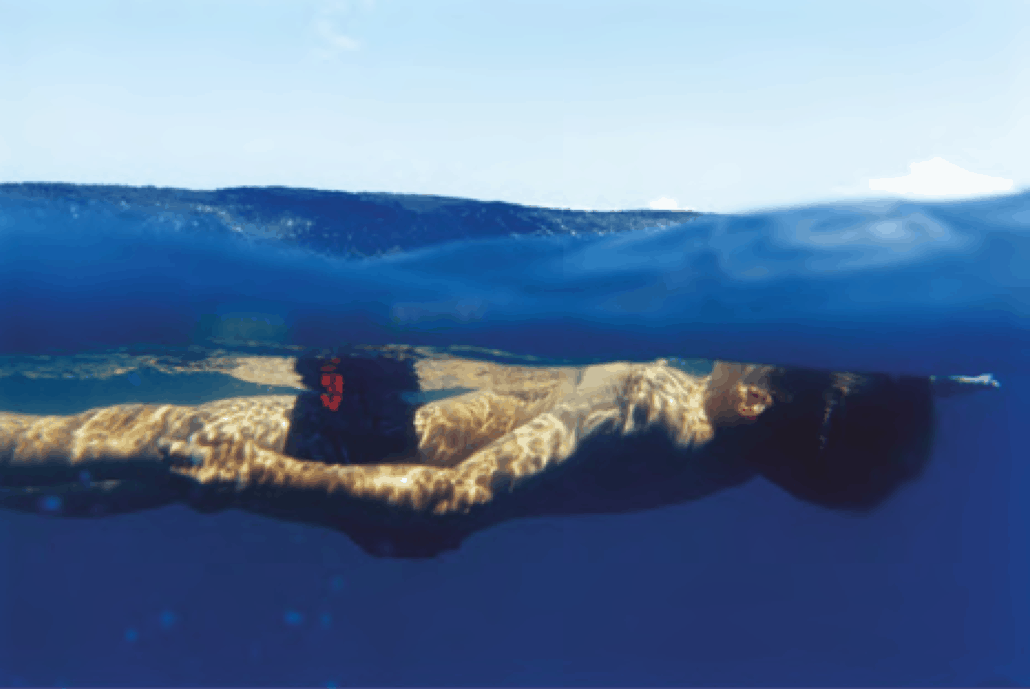 River Notes (Beli, Cres, Croatia), 2014, photograph. Courtesy of the artist.
River Notes (Beli, Cres, Croatia), 2014, photograph. Courtesy of the artist.
The series acts as a type of visual poetry, which could be seen as collective visions and experiences of everyday life that transcend into another space, the unfamiliar within the mundane, creating a kind of alchemy.
Metaphors are constructed for external and internal worlds that require a shift in perception triggering the collective consciousness—the telling of known and unknown stories, personal and public.
River Notes finds its initial inspiration in Bill Callahan’s song Ride My Arrow. River Notes explores the various aspects of entropy within daily life. Callahan sings, “Is life a ride to ride/ Or a story to shape and confide/ Or chaos neatly denied?” Literally and metaphorically the work addresses the relationships between movement, focus, meditation, and change.
This is achieved through a range of contemplative still lives to candid, playful and joyous moments—all of which, together, allow the viewer and reader to gain insight into what the entropy of life can entail. To point to, or better, affirm ordered chaos—putting the brakes on entropy!
RENÉE HOLLEMAN
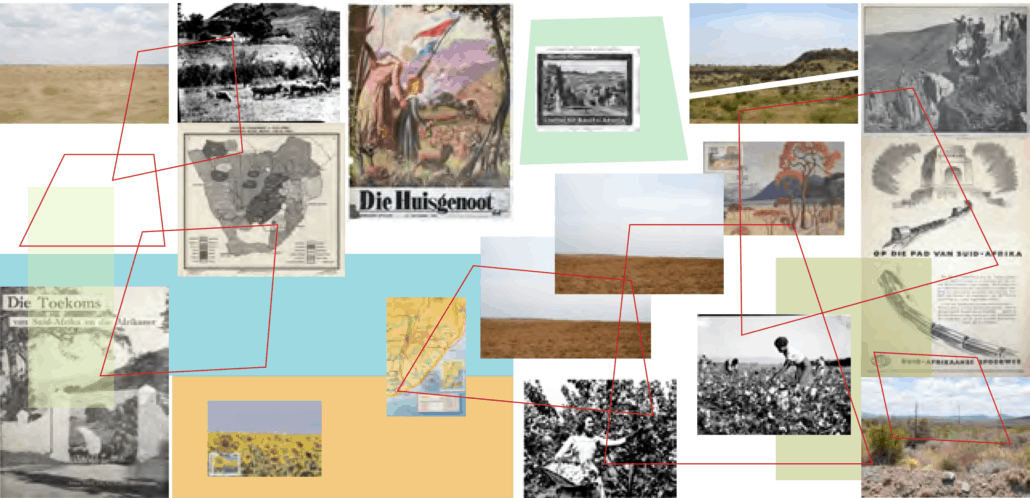 Delineations (Veld, Farm, Futures), 2019, digital collage. Courtesy of the artist.
Delineations (Veld, Farm, Futures), 2019, digital collage. Courtesy of the artist.
Renée Holleman invokes the conceptual, metaphorical, and literal power of lines in her work. For her, the political dimension of employing lines points us to the fact that, for example, when you connect two points you’re making a claim about how space should be organized, and about who gets to organize it. In Delineations she employs idioms from photography and cartography to create constellations of images drawn from sites such as the South African Railways collection. These evoke the seamless progression from transport infrastructure to a view of land (open, empty) that lends itself to white nationalism. For instance, it comes as no accident of history to Holleman that Jacobus Hendrik Pierneef was the artist commissioned in 1929 to paint the 32 panels for the interior of the Johannesburg Railway Station. Taken at speed moving along national and capillary roads, Holleman’s own photographs mark this same link by fraying it. Juxtaposed with their archival ancestors, these are ordinary, impenetrable spaces, their imaging offering no stable ground from which to admire the view. Holleman’s later division of the images, rupturing their integrity as surfaces, heightens this instability by decoupling sight from possession. We may still “take” a photograph, but these photographs can’t hold their contents, nor are they viable commodities. In other places, the result of her deep dive into viewing is hard to look at. When it surfaces, the past is ugly, and even more so when its presence reveals just how present it still is. Historical fragments show us so many gaping holes and racist misrepresentations. Holleman marks the presence of these; how they disturb and demand disturbance. But it matters to her that such representations are not facts. They are the products of a particular point of view, then other points of view become possible.
WE CAME FROM LEFT, WE CAME FROM RIGHT: On displacement, errantry and dispersal
MILENA SCHEREZADE CARRANZA VALCÁRCEL
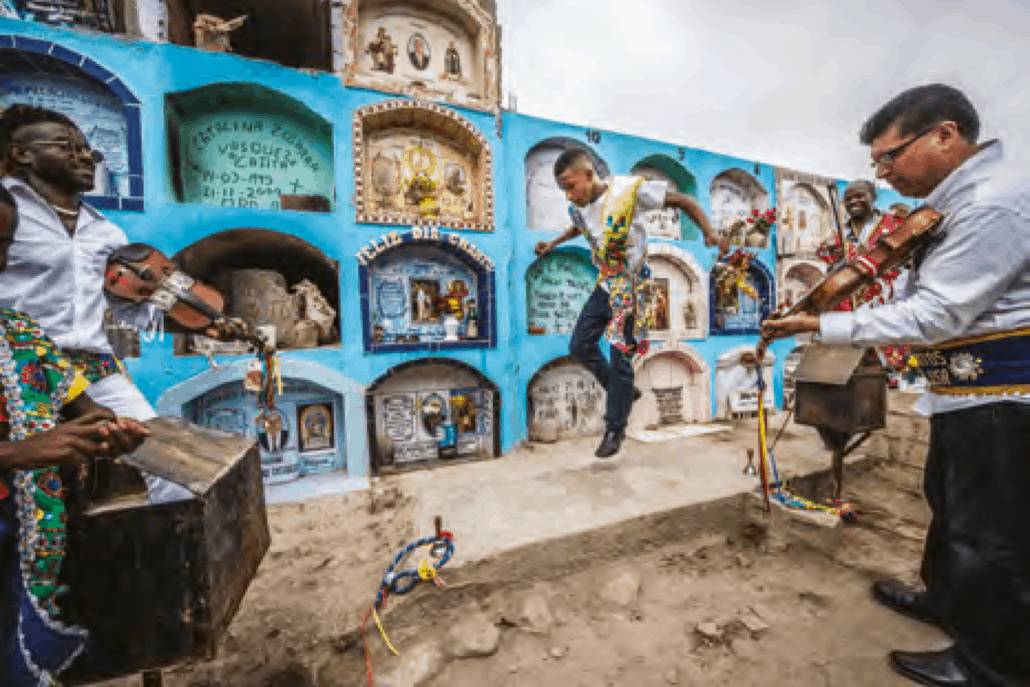 L’Atajo de Negritos d’Amador Ballumbrosio – Spiritualité Afropéruvienne, 2015, photograph. Courtesy of the artist.
L’Atajo de Negritos d’Amador Ballumbrosio – Spiritualité Afropéruvienne, 2015, photograph. Courtesy of the artist.
In southern Peru, in the Ica Valley, as well as in Cusco, the capital of the Incas, the Atajos de Negritos (groups of dancers) and Pallitas (groups of dancers), with their foreman, their corporal, their violinists, and tap dancers come out to celebrate the birth of baby Jesus at Christmas. This is one of the most impressive religious celebrations of our country, in which the Spanish, African, and Andean cultures were syncretized, and it was declared in 2010 Immaterial Cultural Heritage of the Nation—PCI.
Amador Ballumbrosio Mosquera (1933-2009), a peasant and artist, is one of the main people responsible for preserving this tradition. Born in El Carmen, Afro-Peruvian district of the province of Chincha, in the department of Ica, he dedicated his life to the culture of Atajo, helping to preserve the 26 original dances dating back more than 500 years, which evoke for example, the work of the earth, the devotion to the Virgin Mary or the protest against the slave regime.
In this way, in order to perpetuate this heritage, the Cultural Center Amador Ballumbrosio invites Milena to record the courses of the Atajo in 2009 which is, with the death of Amador, now preserved by his children. She has been accompanying her since then with fervour, helping even with the declaration as PCI.
This selection, in particular, shows the course of 2015, from the baptism of the new dancers to the end with the burning of the crib, and we transmit the deep faith and devotion of this practice. Thanks to Milena’s committed vision, and the ancestral unconscious flow, we are enveloped through every image in this sacred experience.
THE TWIGS SHALL NOT PIERCE OUR EYES: On the possibility of hope and the future as promise
FOTOTALA KING MASSASSY
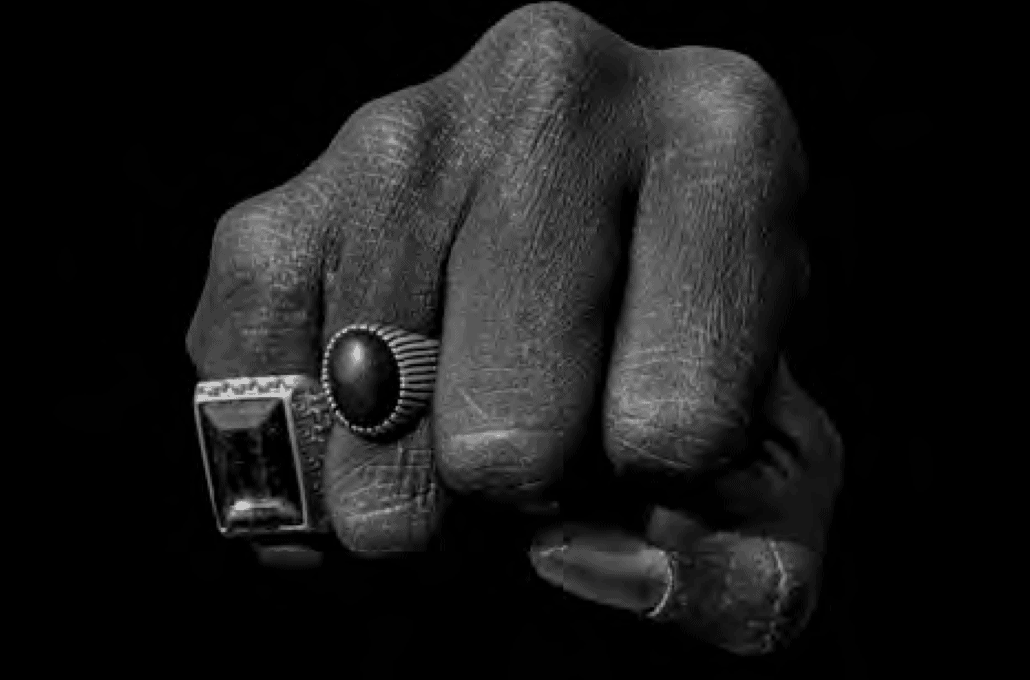 Tenir (Diforme), 2019, photograph. Courtesy of the artist.
Tenir (Diforme), 2019, photograph. Courtesy of the artist.
1995, Montgomery, Alabama: Fototala King Massassy met Rosa Parks during a tour with his rap band SOFA throughout American cities that had been marked by the struggles for civil rights. She told him how she, along figures like Martin Luther King, the Black Panthers, and many others, had clenched and raised their fists to say no to injustice in the 1950s and 1960s. Following this encounter, the first record of Malian hip-hop was born, in which SOFA denounced Arabo-Muslim slavery and the triangular trade, and tried to restore to a Black Man a humanity of which he had been deprived.
Nearly twenty-five years later, Fototala King Massassy takes up this symbol of the fight for emancipation in his series Tenir, a hymn to Africanity as a global concept rather than a concept reduced to the borders of the continent to which it relates. The photographer offers us portraits of a new kind: with the symbolism of the strength, unity and defiance behind these tight fists that have accompanied so many struggles even beyond the US, he portrays an African and afro-descendant identity which is determined, united, and courageous in relation to its tumultuous history. And to emphasize the desire for resistance that characterizes it, through his encounters, sometimes fortuitous, at the corner of a street, sometimes orchestrated, with masters in occult sciences—the photographer has captured fists adorned with lucky rings, whose purpose is to provide protection or invulnerability to those who wear them. On some of these rings, magic formulas, sacred symbols or scriptures are engraved; others are adorned with objects or stones under which talismans prescribed by masters in occult sciences, guardians of esoteric secrets, are buried. What Fototala King Massassy sees in these ornaments which cover hands’s decrepit skins is these of human beings who resist.
KHALIL NEMMAOUI
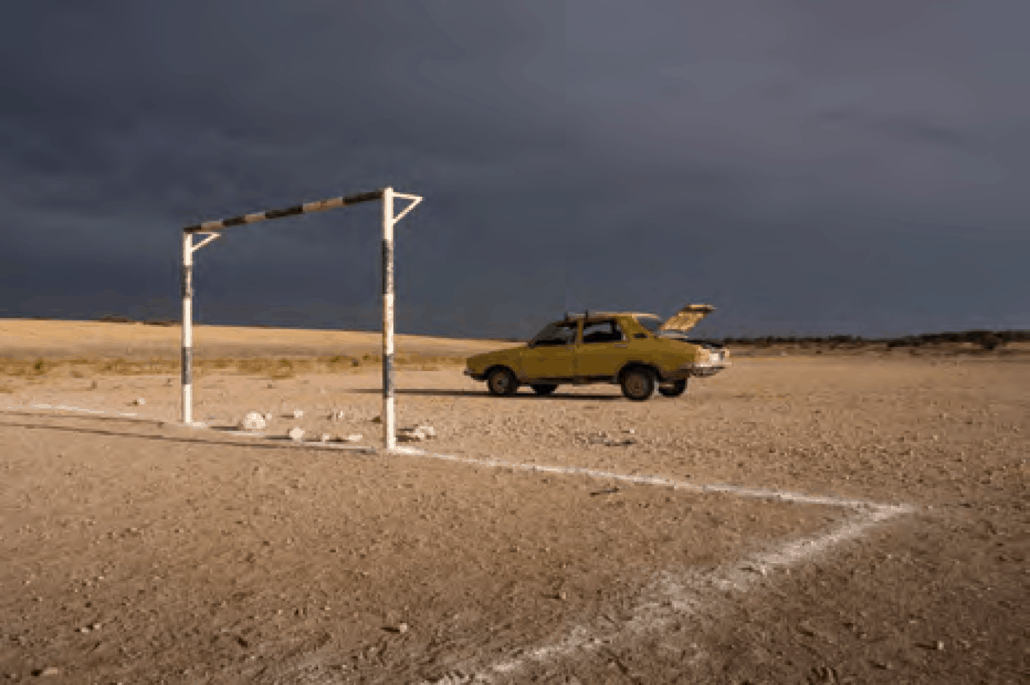 Air Twelve land, photograph, 2019. Courtesy of the artist.
Air Twelve land, photograph, 2019. Courtesy of the artist.
Nemmaoui’s project begun as a fascination with the proliferation of the Renault 12 (R12), a mid-size family car, in the town of Sidi Mokhtar between Essaouira and Marrakech in Morrocco. The artist stages the sedan in compositions that situate the geometric form of the automobile in the context of arid landscapes and in relation to other vegetative, regularly, and irregularly shaped forms. Nemmaoui’s genre scenes consciously decenter the human subject in their compositional frameworks. His pictures emerge from chance encounters with derelict or fully operational R12s in various circumstances out of which his poetic scenes are constructed. The R12 is the recurring motif throughout these photos—sometimes centered, other times playing a peripheral role in the composition. The illusion of repetition is achieved only in visual structure but not in content; the different photos stage individually distinct vehicles which may look the same (if not for them being different colours). It is as though the artist is constructing visual relations that explore and intersect the worlds of organic, architectural, and mechanical technologies by creating a relationship of interdependency and necessity.
COLLECTIVES
COLLECTIF ORCHESTRE VIDE
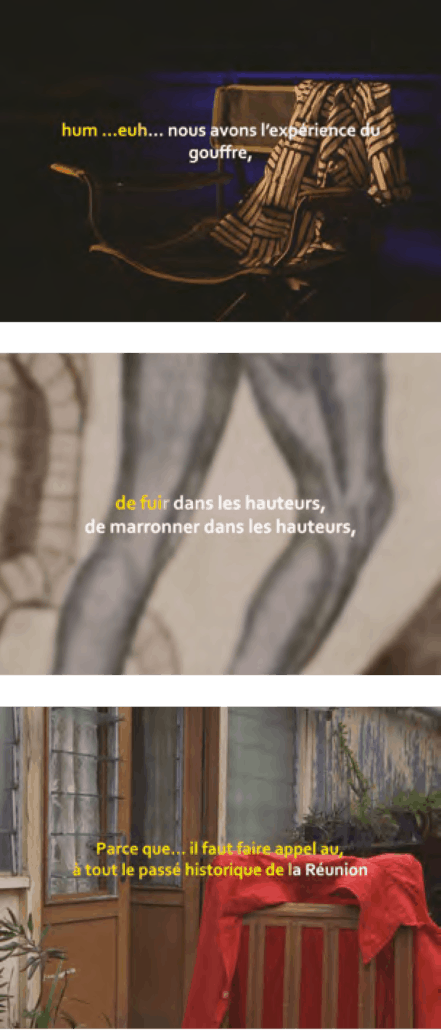 Yohann Queland de Saint-Pern & Myriam Omar Awadi, Orchestre Vide (Karaoké de la pensée), 2016-2019, performative dispositif. Courtesy of the artists and La Colonie.
Yohann Queland de Saint-Pern & Myriam Omar Awadi, Orchestre Vide (Karaoké de la pensée), 2016-2019, performative dispositif. Courtesy of the artists and La Colonie.
Orchestre Vide or “Empty Orchestra” (literally translated from the Japanese term “karaoke”) is a collective project that stems from a reflection on the question of knowledge and the relationships that exist between scientific and artistic practices. The project reimagines scientific content in artistic form. The installation consists of videos with speeches, conferences, and other “famous” communications of theoreticians, scholars, writers, poets, politicians, visual artists, and fictional characters from films and archival documents (including Gilles Deleuze, Édouard Glissant, and Paul Vergès), distributed in a performative and participatory form by involving spectators who will be invited to say or perform these texts within the popular and convivial format of karaoke. The work could also be considered as a kind of reenactment by the public of some of the big lectures, interviews, or moments that have significantly shaped history and changed our perception of the world. In this performative installation, the desire for orality is privileged overwriting. The wish to listen to thought is also emphasized over its reading.
INVISIBLE BORDERS
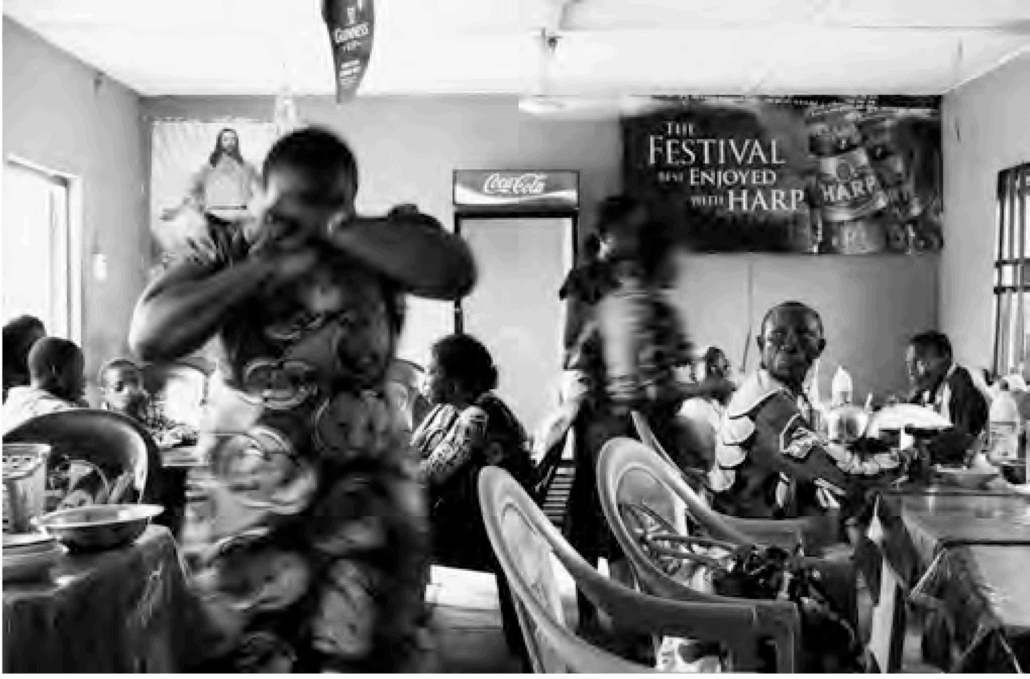 Emeka Okereke, Wishful Thinking 2, Benin, Nigeria, 2011, photograph. Courtesy of the artist.
Emeka Okereke, Wishful Thinking 2, Benin, Nigeria, 2011, photograph. Courtesy of the artist.
The politics of borders continues to take newer shapes and forms as government policies, conflict and militancy displace millions of people across the globe. Still, there is a growing desire from one side of the continent to the other to make permeable, these stark dividing lines increasingly impacting interactions across them as the ideals and benefits of pan Africanism become more appealing and economically attractive to governments and individuals alike. Since 2009, the Invisible Borders Trans African Photography Organisation has continued to traverse the continent deepening understanding of its borders through lived experiences and remarkable encounters using mediums of photography, literature and film. The organisation’s work is strongly rooted in a desire to, one one hand; experience and document stories, culture, intimate encounters, the poetry of presence and journeying across borders via roads; and on the other hand; to shift predominant narratives about Africa away from traditional media reportage which are so often filtered through coloured or narrow lenses intended to fit preconceived prototypes and tropes.
In 2018, the Invisible Borders Trans African Photography Organisation embarked on the 8th Edition of its Trans-African Road Trip from Lagos, Nigeria to Maputo, Mozambique. Intended to take place in two batches, the first set of artists—photographers, writers and filmmakers—travelled from Lagos, Nigeria through Cameroon, the Democratic Republic of Congo ending in Kigali, Rwanda- da. The 2018 Lagos-Maputo Road Trip was premised on two phrases drawn from the conceptual premise of the road trip: “volatile negotiations between past and present” and “I am where I think”.
The former speaks to the historicity of the Lagos to Maputo trans-African highway and the politics of movement along that path while the latter speaks to the thread which runs through the road trips year after year: the body, not only as a vessel of presence and movement but also an active thinking tool wherever it is positioned on the road.
In the 45 days the artists journeyed, these guiding phrases served as grounding anchors alongside personal themes, albeit loosely adhered to, which informed the works they created on the road largely from premeditated and mostly chance encounters and interactions. Photographer and filmmaker, Kenechukwu Nwatu went in search of musical encounters seeking to what extent it is a derivative of spirituality. Writer, Tope Salaudeen- Adegoke wandered into many markets searching for stories at the pulse of daily transactions, especially from women. Emeka Okereke had, as a guiding theme, “Dream Chamber”—a photographic body of work aimed at articulating something of “the ground shifting under our feet” in the process of border renegotiations and reconfigurations taking place in various forms and scales across the continent. Writer, Kay Ugwuede, went into the road questioning, as a path to understanding the differences which result from demarcations of any kind.
Some of these works are going to be up for viewing in a multimedia exhibition during the course of the Bamako Festival.
In addition to the multimedia exhibition featuring a non-linear film of the Lagos-Maputo Road Trip, images and text from a dedicated blog where artists shared their work on the road, the Invisible Borders will also host a 10-day workshop prior to the opening of the festival and involving up to 10 writers, photographers and filmmakers in Bamako; and a public space exhibition of photographs and texts from the Invisible Borders archive.
The 2018 Lagos-Maputo Road Trip is ongoing. The Batch B and final leg of the trip is scheduled to continue at a later date, and so, this component of our exhibition will take the form of a work in progress.
—Kay Ugwuede
KOLEKTIF 2 DIMANSYON (K2D)
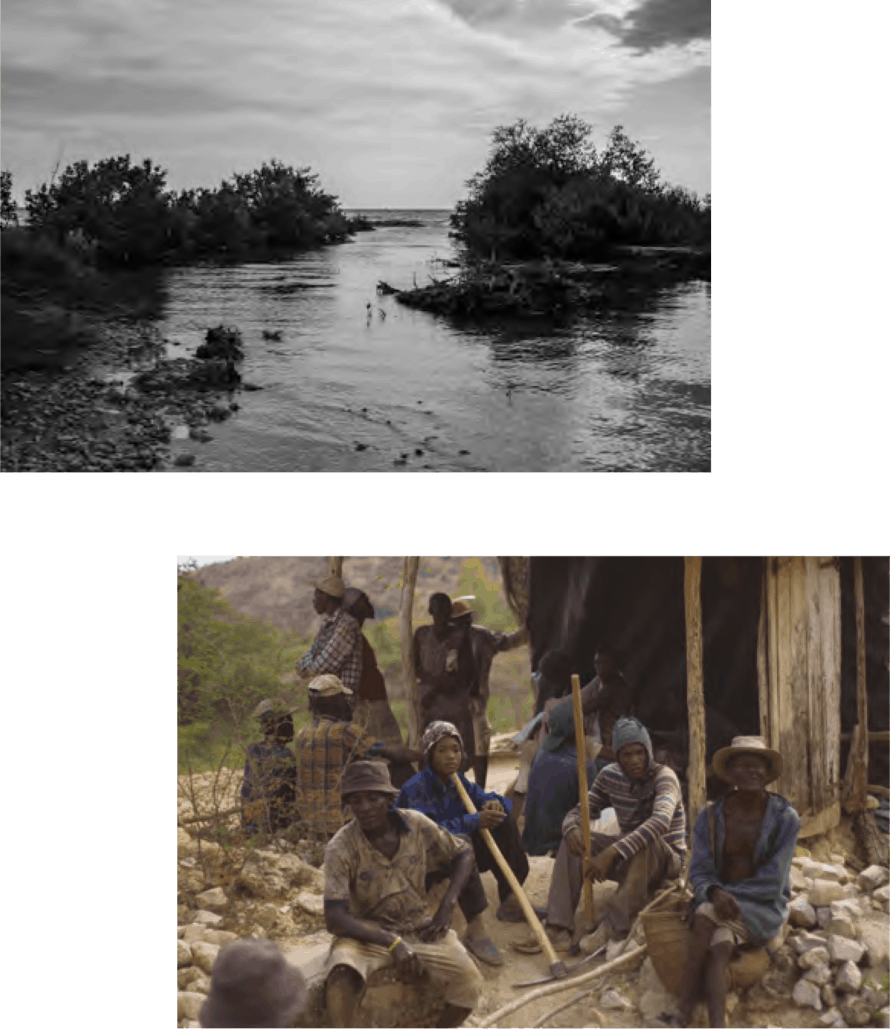 TOP: Kazal Moise, Orifice in the Bretelle river. The river is the first link between Kazal and Cabaret, renamed Duvaliervill under the rule of François Duvalier, Cabaret, 2015, photograph. Credit: Moise Pierre. BOTTOM: Kazal Mackenson, Farmers taking a break in Desab, a part of Cabaret, 2016, photograph.Credit: Mackenson Saint-Félix.
TOP: Kazal Moise, Orifice in the Bretelle river. The river is the first link between Kazal and Cabaret, renamed Duvaliervill under the rule of François Duvalier, Cabaret, 2015, photograph. Credit: Moise Pierre. BOTTOM: Kazal Mackenson, Farmers taking a break in Desab, a part of Cabaret, 2016, photograph.Credit: Mackenson Saint-Félix.
This year marks the commemoration of the fiftieth anniversary of the massacre of Kazal, a village in the north of Port-au-Prince which became, in the spring of 1969, the horrific scene of one of the most tragic events in the contemporary history of the country. Under the dictatorship of François Duvalier, marked by terror and corruption, peasants rose up in protest against abusive taxes and bans on the consumption of the water from the river that flowed through their village. The uprising was soon crushed by the regime’s military and militia, ending up with a disastrous record of at least 23 peasants killed, 80 missing, and 82 houses burned. If the event has been obliterated from official history, the memory of its atrocity still subsists through the testimonies of survivors and the vestiges it has scattered in the landscape and the daily life of the inhabitants of Kazal. Utilizing the potential of photography as a tool of memory narration, six Haitian photographers from the first post-Duvalier generation embarked in a work of remembrance to address the scars of the past and get rid of the spectre of the ruthless dictatorship that still hovers over the Kazaleses and the Haitians in general, and across generations. For three years, they have gone to the encounter of the people of Kazal to interrogate their memories of places and events. Kazal is the result of a long and emotional journey which required them to deploy strategies to overcome social, cultural, and geographical barriers to be capable of restituting what is left from memories that have been crumbled by time. Through a double-perspective narration, the collective constructed a fragmented and subjective testimony that will of course never fully grasp the reality of that historical fact, but at least produce a late reference archive and reactivate a reflection around its memory.
SPECIAL PROJECTS
THE WORKS OF TOLA ODUKOYA
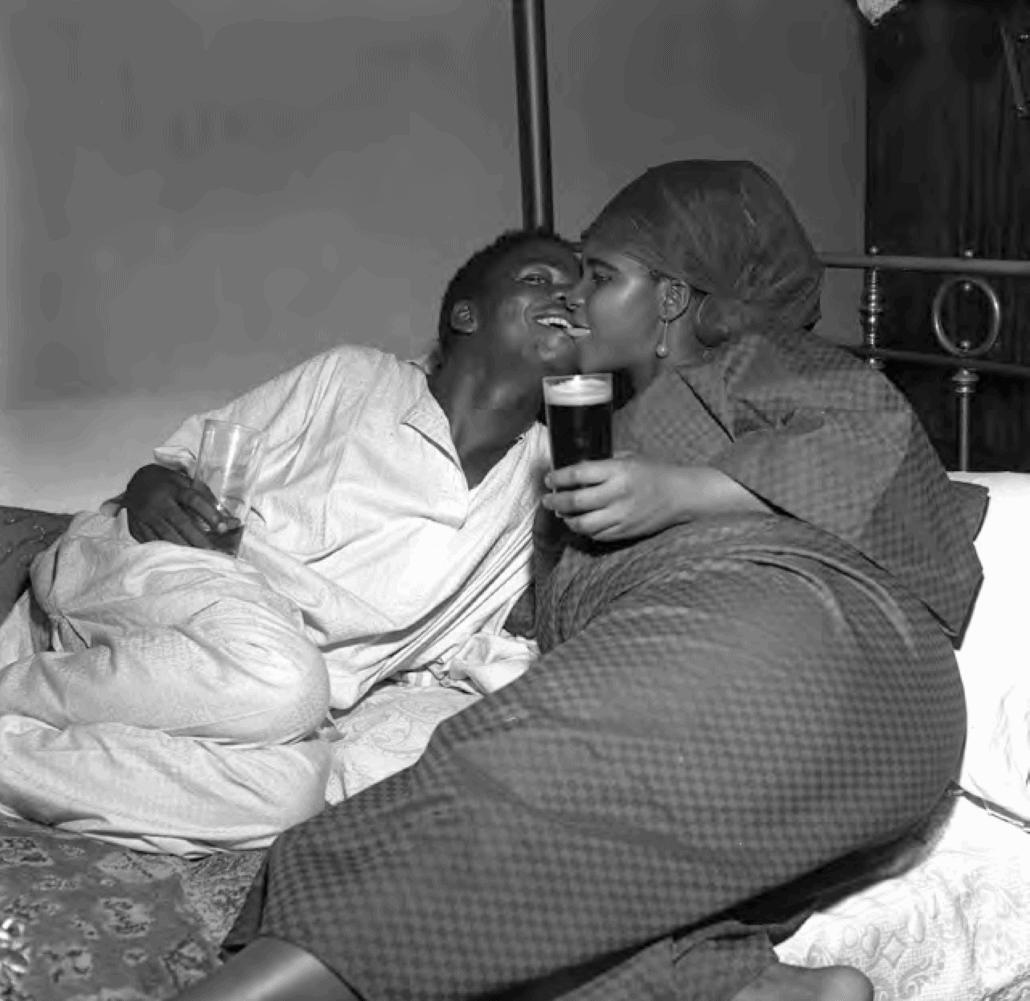 Couple in Bed, 1965.
Couple in Bed, 1965.
Odukoya’s graphically engineered images instigates the question of the purpose of memory. As we are exposed to the photographs created by Tola Odukoya, it seems we have started tracing and retracing and historically examining the tracks of Africa’s cultural highways. The mission here is simply to present a selection of twenty images from his collection of over two-thousand photographs that has been created over a career of more than forty years. Odukoya’s multilayered work unpacks a series of questions and goes further to declare an emergency about the need to open fresh conversations around the complexities of the relationship and effect of culture on demographics, especially in the African continent. The discovery of Tola Odukoya’s work further reinforces the urgency to widen our scope of view and rethink our position on photography and Africa.
The above excerpts, taken from the biennale catalogue, are exhibitions to look forward to at the 12th edition of Rencontres de Bamako. Rencontres de Bamako will run until the 31st of January 2020.



